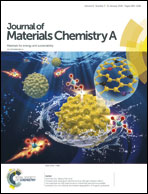Red-blood-cell-like (NH4)[Fe2(OH)(PO4)2]·2H2O particles: fabrication and application in high-performance LiFePO4 cathode materials†
Abstract
A well-crystallized (NH4)[Fe2(OH)(PO4)2]·2H2O particle with a red-blood-cell-like (RBC-like) shape has been synthesized via a simple sonochemical method, and is employed as the precursor to fabricate LiFePO4/C as a cathode material for Li-ion batteries. The morphology evolution of (NH4)[Fe2(OH)(PO4)2]·2H2O from a nanoparticle to a nanoplate (∼50 nm in thickness) and to a RBC-like discoid is observed by increasing the reaction time. The formation mechanism of this kind of RBC-like shape can be understood as nucleation, crystallization, formation of thin plates, and self-assembly. The precursor and corresponding LiFePO4/C are characterized by XRD, SEM, TEM, charge–discharge tests and CV measurements. The results show that the morphology of the (NH4)[Fe2(OH)(PO4)2]·2H2O precursor turns from a RBC-like structure into an irregular structure and the size becomes much smaller for LiFePO4/C during the solid-state reaction process. The fabricated LiFePO4/C exhibits excellent rate performance with a discharge capacity of 113.4 mA h g−1 even at 10C and a capacity fading rate of 3.5% after 300 cycles. Thus, this kind of uniquely shaped (NH4)[Fe2(OH)(PO4)2]·2H2O shows potential application in high-power Li-ion batteries.
![Graphical abstract: Red-blood-cell-like (NH4)[Fe2(OH)(PO4)2]·2H2O particles: fabrication and application in high-performance LiFePO4 cathode materials](/en/Image/Get?imageInfo.ImageType=GA&imageInfo.ImageIdentifier.ManuscriptID=C7TA08413G&imageInfo.ImageIdentifier.Year=2018)


 Please wait while we load your content...
Please wait while we load your content...